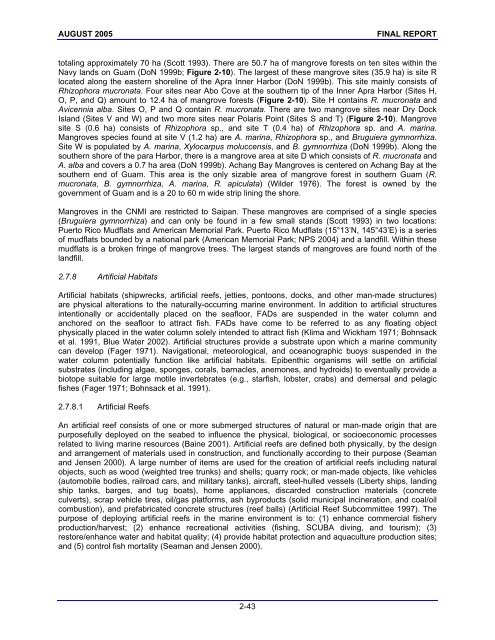Marine Resources Assessment for the Marianas Operating ... - SPREP
Marine Resources Assessment for the Marianas Operating ... - SPREP
Marine Resources Assessment for the Marianas Operating ... - SPREP
Create successful ePaper yourself
Turn your PDF publications into a flip-book with our unique Google optimized e-Paper software.
AUGUST 2005 FINAL REPORT<br />
totaling approximately 70 ha (Scott 1993). There are 50.7 ha of mangrove <strong>for</strong>ests on ten sites within <strong>the</strong><br />
Navy lands on Guam (DoN 1999b; Figure 2-10). The largest of <strong>the</strong>se mangrove sites (35.9 ha) is site R<br />
located along <strong>the</strong> eastern shoreline of <strong>the</strong> Apra Inner Harbor (DoN 1999b). This site mainly consists of<br />
Rhizophora mucronata. Four sites near Abo Cove at <strong>the</strong> sou<strong>the</strong>rn tip of <strong>the</strong> Inner Apra Harbor (Sites H,<br />
O, P, and Q) amount to 12.4 ha of mangrove <strong>for</strong>ests (Figure 2-10). Site H contains R. mucronata and<br />
Avicennia alba. Sites O, P and Q contain R. mucronata. There are two mangrove sites near Dry Dock<br />
Island (Sites V and W) and two more sites near Polaris Point (Sites S and T) (Figure 2-10). Mangrove<br />
site S (0.6 ha) consists of Rhizophora sp., and site T (0.4 ha) of Rhizophora sp. and A. marina.<br />
Mangroves species found at site V (1.2 ha) are A. marina, Rhizophora sp., and Bruguiera gymnorrhiza.<br />
Site W is populated by A. marina, Xylocarpus moluccensis, and B. gymnorrhiza (DoN 1999b). Along <strong>the</strong><br />
sou<strong>the</strong>rn shore of <strong>the</strong> para Harbor, <strong>the</strong>re is a mangrove area at site D which consists of R. mucronata and<br />
A. alba and covers a 0.7 ha area (DoN 1999b). Achang Bay Mangroves is centered on Achang Bay at <strong>the</strong><br />
sou<strong>the</strong>rn end of Guam. This area is <strong>the</strong> only sizable area of mangrove <strong>for</strong>est in sou<strong>the</strong>rn Guam (R.<br />
mucronata, B. gymnorrhiza, A. marina, R. apiculata) (Wilder 1976). The <strong>for</strong>est is owned by <strong>the</strong><br />
government of Guam and is a 20 to 60 m wide strip lining <strong>the</strong> shore.<br />
Mangroves in <strong>the</strong> CNMI are restricted to Saipan. These mangroves are comprised of a single species<br />
(Bruguiera gymnorrhiza) and can only be found in a few small stands (Scott 1993) in two locations:<br />
Puerto Rico Mudflats and American Memorial Park. Puerto Rico Mudflats (15°13’N, 145°43’E) is a series<br />
of mudflats bounded by a national park (American Memorial Park; NPS 2004) and a landfill. Within <strong>the</strong>se<br />
mudflats is a broken fringe of mangrove trees. The largest stands of mangroves are found north of <strong>the</strong><br />
landfill.<br />
2.7.8 Artificial Habitats<br />
Artificial habitats (shipwrecks, artificial reefs, jetties, pontoons, docks, and o<strong>the</strong>r man-made structures)<br />
are physical alterations to <strong>the</strong> naturally-occurring marine environment. In addition to artificial structures<br />
intentionally or accidentally placed on <strong>the</strong> seafloor, FADs are suspended in <strong>the</strong> water column and<br />
anchored on <strong>the</strong> seafloor to attract fish. FADs have come to be referred to as any floating object<br />
physically placed in <strong>the</strong> water column solely intended to attract fish (Klima and Wickham 1971; Bohnsack<br />
et al. 1991, Blue Water 2002). Artificial structures provide a substrate upon which a marine community<br />
can develop (Fager 1971). Navigational, meteorological, and oceanographic buoys suspended in <strong>the</strong><br />
water column potentially function like artificial habitats. Epibenthic organisms will settle on artificial<br />
substrates (including algae, sponges, corals, barnacles, anemones, and hydroids) to eventually provide a<br />
biotope suitable <strong>for</strong> large motile invertebrates (e.g., starfish, lobster, crabs) and demersal and pelagic<br />
fishes (Fager 1971; Bohnsack et al. 1991).<br />
2.7.8.1 Artificial Reefs<br />
An artificial reef consists of one or more submerged structures of natural or man-made origin that are<br />
purposefully deployed on <strong>the</strong> seabed to influence <strong>the</strong> physical, biological, or socioeconomic processes<br />
related to living marine resources (Baine 2001). Artificial reefs are defined both physically, by <strong>the</strong> design<br />
and arrangement of materials used in construction, and functionally according to <strong>the</strong>ir purpose (Seaman<br />
and Jensen 2000). A large number of items are used <strong>for</strong> <strong>the</strong> creation of artificial reefs including natural<br />
objects, such as wood (weighted tree trunks) and shells; quarry rock; or man-made objects, like vehicles<br />
(automobile bodies, railroad cars, and military tanks), aircraft, steel-hulled vessels (Liberty ships, landing<br />
ship tanks, barges, and tug boats), home appliances, discarded construction materials (concrete<br />
culverts), scrap vehicle tires, oil/gas plat<strong>for</strong>ms, ash byproducts (solid municipal incineration, and coal/oil<br />
combustion), and prefabricated concrete structures (reef balls) (Artificial Reef Subcommittee 1997). The<br />
purpose of deploying artificial reefs in <strong>the</strong> marine environment is to: (1) enhance commercial fishery<br />
production/harvest; (2) enhance recreational activities (fishing, SCUBA diving, and tourism); (3)<br />
restore/enhance water and habitat quality; (4) provide habitat protection and aquaculture production sites;<br />
and (5) control fish mortality (Seaman and Jensen 2000).<br />
2-43
















